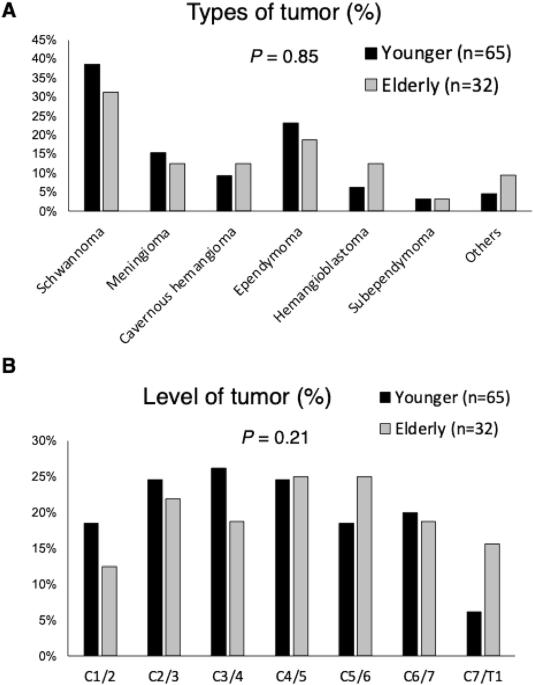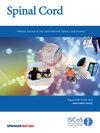Surgical outcomes of cervical spinal cord tumor in elderly patients assessed by the Japanese Orthopedic Association Cervical Myelopathy Evaluation Questionnaire
IF 2.2
4区 医学
Q3 CLINICAL NEUROLOGY
引用次数: 0
Abstract
Single-institution retrospective study. To assess postoperative functional and quality of life (QOL) outcomes in elderly patients who underwent cervical spinal cord tumor surgery using the Japanese Orthopedic Association Cervical Myelopathy Evaluation Questionnaire (JOACMEQ). Single university hospital. This retrospective study included 97 patients who underwent surgery for cervical spinal cord tumors between 2000 and 2016. Patients were divided into two groups: a younger group (patients < 65 years old) and an elderly group (patients ≥ 65 years old). Surgical outcomes were evaluated using JOA scores and JOACMEQ, with statistical comparisons between age (younger vs. elderly) and tumor types (intramedullary vs. extramedullary). Preoperative JOA scores were significantly lower in the elderly group compared to the younger group. Postoperative recovery rates were similar between the two groups. Extramedullary tumor resections in the elderly showed notable functional improvements. Conversely, elderly patients with intramedullary tumors exhibited poorer outcomes in lower extremity function and QOL, as measured by the JOACMEQ. Surgical intervention for cervical spinal cord tumors in elderly patients can yield functional and QOL outcomes similar to those in younger patients, especially for extramedullary tumors. However, intramedullary tumor resections in the elderly may result in less favorable outcomes, particularly in lower limb function and QOL. These findings underscore the importance of thorough preoperative counseling for elderly patients, highlighting potential risks and benefits based on tumor type.

日本骨科协会颈椎病评估问卷评估老年患者颈脊髓肿瘤的手术效果。
研究设计:单机构回顾性研究。目的:使用日本骨科协会颈脊髓病评估问卷(JOACMEQ)评估老年颈脊髓肿瘤手术患者的术后功能和生活质量(QOL)结果。环境:单一的大学医院。方法:本回顾性研究纳入了2000年至2016年间接受颈脊髓肿瘤手术治疗的97例患者。患者分为两组:年轻组(患者)结果:术前老年组JOA评分明显低于年轻组。两组术后恢复率相似。老年人髓外肿瘤切除后功能明显改善。相反,老年髓内肿瘤患者在下肢功能和生活质量方面表现出较差的结果,由JOACMEQ测量。结论:老年颈脊髓肿瘤的手术治疗可获得与年轻患者相似的功能和生活质量,特别是髓外肿瘤。然而,老年人髓内肿瘤切除术可能导致不太有利的结果,特别是在下肢功能和生活质量方面。这些发现强调了对老年患者进行全面术前咨询的重要性,强调了基于肿瘤类型的潜在风险和益处。
本文章由计算机程序翻译,如有差异,请以英文原文为准。
求助全文
约1分钟内获得全文
求助全文
来源期刊

Spinal cord
医学-临床神经学
CiteScore
4.50
自引率
9.10%
发文量
142
审稿时长
2 months
期刊介绍:
Spinal Cord is a specialised, international journal that has been publishing spinal cord related manuscripts since 1963. It appears monthly, online and in print, and accepts contributions on spinal cord anatomy, physiology, management of injury and disease, and the quality of life and life circumstances of people with a spinal cord injury. Spinal Cord is multi-disciplinary and publishes contributions across the entire spectrum of research ranging from basic science to applied clinical research. It focuses on high quality original research, systematic reviews and narrative reviews.
Spinal Cord''s sister journal Spinal Cord Series and Cases: Clinical Management in Spinal Cord Disorders publishes high quality case reports, small case series, pilot and retrospective studies perspectives, Pulse survey articles, Point-couterpoint articles, correspondences and book reviews. It specialises in material that addresses all aspects of life for persons with spinal cord injuries or disorders. For more information, please see the aims and scope of Spinal Cord Series and Cases.
 求助内容:
求助内容: 应助结果提醒方式:
应助结果提醒方式:


